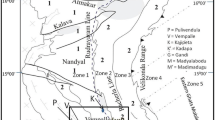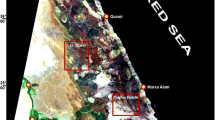Abstract
The Wadi Faliq El Sahl–Faliq El Waar area comprises four various types of rocks including metavolcanics, older granites, Hammamat sediments, and younger granites of monzogranite and syenogranite composition. From the various structural analyses in the investigated area, the main trends controlling the structural and tectonic framework are ENE-WSW and NE-SW, while the trends NNE-SSW, WNW-ESE, and N-S are less abundant. Three major phases of deformation are detected in the study area, each of which gives its specific trends according to the applied stress axis during the time of deformation. The first phase shows compressive stress whose σ1 maximum compressional axis was E-W trend (N81°W). The second phase is a compression phase in which the σ1 maximum compression axis was directed N13°W. The third phase represents a trans-tensional (extensional) stress system, in which the maximum tension force (σ1) is in the N-S trend. The study area passed through four stages of evolution, which are (1) the arc-metavolcanic formation with island arc assemblage and the intrusion of older granitoids during the inter-collision of the island arcs; (2) the tectonic processes forming the inter-mountainous basins; (3) the folding of the Hammamat basin under Najd-related shear zones; and (4) the intrusion of syenogranite and uplifting of the Hammamat sediments during the Late Precambrian rifting. The potash-rich outer zone of pegmatite bosses in the younger granites recorded high values of gamma radioactivity with U content.

















Similar content being viewed by others
References
Abd El-Wahed MA (2007) Late Pan-African tectonic evolution and strain determinations in the Late Neoproterozoic molasse sediments, Eastern Desert, Egypt: evidence for post-Hammamat compression and transpression. Egypt J Geol 51:1–39
Abd El-Wahed MA (2010) The role of the Najd Fault System in the tectonic evolution of the Hammamat molasse sediments, Eastern Desert, Egypt. Arab J Geosci 3:1–26
Abd El-Wahed MA, Harraz HZ, El-Behairy MH (2016) Transpressional imbricate thrust zones controlling gold mineralization in the Central Eastern Desert of Egypt. Ore Geol Rev 78:424–446
Abdeen MM, Abdelghaffar AA (2011) Syn- and post-accretionary structures in the Neoproterozoic Central Allaqi-Heiani suture zone, Southeastern Egypt. Precambrian Res 185:95–108
Ahrens LH (1965) Some observations on the uranium and thorium distribution in accessory zircon from granitic rocks. Geochim Cosmochim Acta 20:715–220
Badgely PC (1959) Structural methods for exploration geologist. Harber and Brothers; New York:280 pp
Bezenjani RN, Pease V, Whitehouseb MJ, Shalaby MH, Kadi KA, Kozdroj W (2014) Detrital zircon geochronology and provenance of the Neoproterozoic Hammamat group (Igla Basin), Egypt and the Thalbah group, Nw Saudi Arabia: implications for regional collision tectonics. Precambrian Res 245:225–243
El-Bialy MZ, Eliwa HA, Mahdy NM, Murata M, El-Gameel KH, Sehsah H, Omar M, Kato Y, Fujinaga K, Andresen A, Thomsen TB (2020) U-Pb zircon geochronology and geochemical constraints on the Ediacaran continental arc and post-collision granites of Wadi Hawashiya, North Eastern Desert, Egypt: insights into the ~600 Ma crust-forming event in the northernmost part of Arabian-Nubian Shield. Precambrian Res 345:105777. https://doi.org/10.1016/j.precamres.2020.105777
El-Din GA, Abdelkareem M (2018) Integration of remote sensing, geochemical and field data in the Qena-Safaga shear zone: implications for structural evolution of the Eastern Desert, Egypt. J Afr Earth Sci 141:179–193. https://doi.org/10.1016/j.jafrearsci.2018.02.014
El-Shazly, E.M. (1964): On the classification of the Precambrian and other rocks of magmatic affiliation in Egypt. XXII Inter. Geol. Congr. Proc. Sect. 10, India, p. 88-101.
Emmel B, Jöns N, Kröner A, Jacobs J, Wartho JA, Schenk V, Razakamanana T, Austegard A (2008) From closure of the Mozambique Ocean to Gondwana breakup: new evidence from geochronological data of the Vohibory Terrane, Southwest Madagascar. J Geol 116:21–38
Faisal M, Yang X, Khalifa IH, Amuda AK, Sun C (2020) Geochronology and geochemistry of Neoproterozoic Hamamid metavolcanics hosting largest volcanogenic massive sulfide deposits in Eastern Desert of Egypt: implications for petrogenesis and tectonic evolution. Precambrian Res 344:105751. https://doi.org/10.1016/j.precamres.2020.105751
Fritz H, Abdelsalam M, Ali KA, Bingen B, Collins AS, Fowler AR, Ghebreab W, Hauzenberger CA, Johnson PR, Kusky TM, Macey P, Muhongo S, Stern RJ, Viola G (2013) Orogen styles in the East African Orogen: a review of the Neoproterozoic to Cambrian tectonic evolution. J Afr Earth Sci 86:65–106
Fowler A, Hamimi Z (2021) A review and synthesis of strain studies in the Egyptian Nubian Shield: materials, methods, problems and prospects. Precambrian Res 355:106072. https://doi.org/10.1016/j.precamres.2020.106072
Geisler T, Rashwan AA, Rahn MKW, Poller U, Zwingmann H, Pidgeon RT, Schleicher H, Tomaschek F (2003) Low-temperature hydrothermal alteration of natural metamict zircons from the Eastern Desert, Egypt. Mineral Mag 67:485–508
Geisler T, Schaltegger U, Tomaschek F (2007) Re-equilibration of zircon in aqueous fluids and melts. Elements 3:43–50
Hamimi Z, Abd El-Wahed MA, Gahlan HA, Kamh SZ (2019) Tectonics of the Eastern Desert of Egypt: key to understanding the Neoproterozoic Evolution of the Arabian–Nubian Shield (East African Orogen). Springer Nature Switzerland:3–14
Hamimi Z and Abd El-Wahed MA (2020) The geology of Egypt (Ch. 5: suture(s) and major shear zones in the Neoproterozoic Basement of Egypt). Springer Nature Switzerland, 150-189.
Helmy MH, Yoshikawa M, Shibata T, Arai S, Kagami H (2015) Sm-Nd and Rb-Sr isotope geochemistry and petrology of Abu Hamamid intrusion, Eastern Desert, Egypt: an Alaskan-type complex in a back-arc setting. Precambrian Res 258:234–246
Johnson PR, Andresen A, Collins AS, Fowler AR, Fritz H, Ghebreab W, Kusky T, Stern RJ (2011) Late Cryogenian-Ediacaran history of the Arabian-Nubian Shield: a review of depositional, plutonic, structural, and tectonic events in the closing stages of the northern East African Orogen. J Afr Earth Sci 61:167–232
Johnson PR, Zoheir BA, Ghebreab W, Stern RJ, Barrie CT, Hamer RD (2017) Gold-bearing volcanogenic massive sulfides and orogenic-gold deposits in the Nubian Shield. S Afr J Geol 120:63–76
Khalifa AA, Khamis HA, El-Sayed MM, Shalaby MH (2020) Geology and evolutionary stages of the Late Precambrian Hammamat sediments at Gebel Um Tawat, North Eastern Desert, Egypt. Arab J Geosci 430:1–19
Kröner A, Eyal M (1990) Early Pan-African evolution of the basement around Elat, Israel, and the Sinai Peninsula revealed by single zircon evaporation dating and implication for crustal accretion rates. Geol. 18:545–548
Kozdroj W, Kennedy AK, Johnson PR, Ziołkowska-Kozdroj M, Khadi K (2018) Geochronology in the southern Midyan terrane: a review of constrints on the timing of magmatic pulses and tectonic evolution in a northwestern part of the Arabian Shield. Int Geol Rev 60(10):1290–1319. https://doi.org/10.1080/00206814.2017.1385425
Moore JM (1979) Tectonics of the Najd Transcurrent Fault System, Saudi Arabia. J Geol Soc Lond 136:441–454
Read HH (1984) Rutley’s elements of mineralogy. Published by S.K. Jain for CBS Publishers and Distributors, Delhi, India, 560p
Stern RJ (1981) Petrogenesis and tectonic setting of late Precambrian ensimatic volcanic rocks, central Eastern Desert of Egypt. Precambrian Res 16:197–232
Stern RJ, Gottfried D, Hedge CE (1984) Late Precambrian rifting and crustal evolution in the North Eastern Desert of Egypt. Geology 12:168–172
Stern RJ (1985) The Najd fault system, Saud Arabia and Egypt: a Late Precambrian rift system? Tectonics 4:497–511
Stern RJ, Hedge CE (1985) Geochronologic and isotopic constraints on late precambrian crustal evolution in the Eastern Desert of Egypt. Am J Sci 258:97–127
Stern RJ (1994) Arc assembly and continental collision in the Neoproterozoic East-African Orogen implications for the consolidation of Gondwanaland. Annu Rev Earth Planet Sci 22:319–351
Turner FJ, Weiss LE (1963) Structural analysis of metamorphic tectonites. McGraw Hill Book Company, Inc., New York, 554pp
Xu X-S, Zhang M, Zhu K-Y, Chen X-M, He Z-Y (2012) Reverse age zonation of zircon formed by metamictisation and hydrothermal fluid leaching. Lithos 150:256–267
Youssef MI (1968) Structural pattern of Egypt and its interpretation. AAPG Bull 52:601–614
Zoheir BA, Johnson PR, Goldfarb RJ, Klemm DD (2019) Orogenic gold in the Egyptian Eastern Desert: widespread gold mineralization in the late stages of Neoproterozoic orogeny. Gondwana Res 75:184–217. https://doi.org/10.1016/j.gr.2019.06.002
Acknowledgements
The authors would like to express their deepest gratitude and appreciation to the reviewers for their fruitful guidance and accurate revision of this manuscript. We also extend our sincere thanks to Abdullah M. Al-Amri, “the chief editor of the Journal of Arabian Journal of Geosciences,” for his effective communication in publishing this article.
Author information
Authors and Affiliations
Corresponding author
Ethics declarations
I declare that no part of the work referred to in this manuscript has been submitted for publication in any other journal nor is it funded by any institution. I also declare that the authors agree to publish this manuscript and that they have no competing interests.
Additional information
Responsible Editor: François Roure
Rights and permissions
About this article
Cite this article
El-Wakel, ES.S., El-Sundoly, H.I., El-Sayed, M.M. et al. Structural analyses and geological studies of the Late Precambrian Basement Complex in Wadi Faliq El Sahl–Faliq El Waar area, North Eastern Desert, Egypt. Arab J Geosci 14, 2025 (2021). https://doi.org/10.1007/s12517-021-08399-z
Received:
Accepted:
Published:
DOI: https://doi.org/10.1007/s12517-021-08399-z




